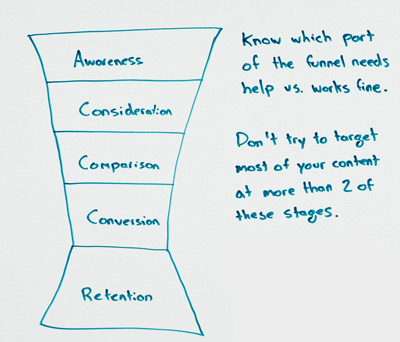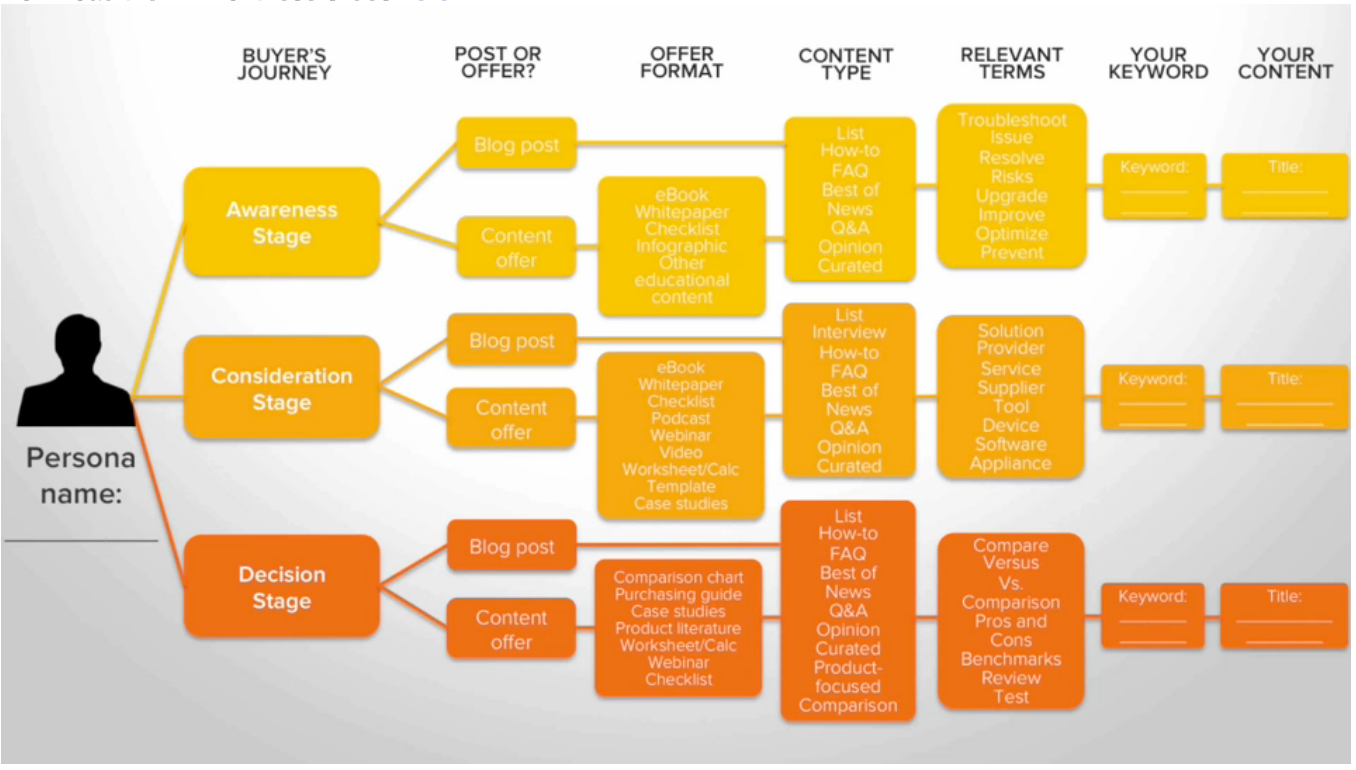The content marketing MVP
Free bonus: A full content marketing plan template is available at the end of this post.
When I was hired to handle marketing at our startup, I was lost at first. I had a few ideas, but no experience, and an unhealthy dose of self-doubt. But I also had some certainties:
- I could write good copy.
- I knew a bit about branding, SEO & other online marketing stuff.
- I knew my way around basic online tools like CMS & social media.
So I decided I'd start focusing on our blog. It'd help me understand our product and our users, and it'd give our startup a decent online presence. That was about as far as my ambition went for our blog.
I didn't have a plan. But our product manager & co-founder didn't care: he told me to go for it and try things out. True to his lean/agile values, he said something like:
"Don't worry, we'll figure it out as we go."
And we did. Through 2+ years of steady content marketing, we all learned a whole damn lot — about our product, our users, our industry, and even ourselves. But most times, we learned the hard way. We wasted hours on unfruitful outreach tactics, days on posts that never helped our business.
Now don't get me wrong: I owe a lot to the get out of the building and put it out there startup mentality. But when it comes to content marketing, taking a few hours to plan your efforts will speed up ROI.
Folks familiar with the lean startup movement already know too well the term MVP (minimum viable product). Well, before you get started with your content, you'll need an MVP. But not the regular kind of MVP. You'll need a minimum viable plan.
Here's hoping this post will save you some of the troubles we went through.
Your MVP should include:
- Defining your audience and a persona
- Structuring your content axis with explicit themes
- Mapping types of content to your conversion funnel steps
- A team memo/meeting to ignite a content mindset
Persona(s): who are you talking to?
How well you know your audience often depends on your business' growth stage. The essence of a young, agile startup's audience might change a few times in its first years. But a long-running, vertical-focused corporation has most likely been marketing to the same people for a long time.
The key here is to create a persona and go beyond the usual, vague audience description:
We're targeting SMB's in the food industry.
No, you're not. You're targeting a human being making decisions based on both emotional and rational factors. Tell us about that person instead:
Lisa is a 35-year-old team manager who works for a specialty sandwich shop chain in Seattle. She's passionate about local, organic food, and she loves to jog with her dog. She manages over 25 young adult employees, spread out between 3 different sandwich joints. It's hard for her to continuously train all these employees and keep track of their performance and satisfaction at work.
Well, that's better. Now you know exactly who you're offering your restaurant staff management software to. And when you start crafting your content, you'll do it with an actual human being in mind. Not just faceless wallets. You'll try to ease Lisa's recurring pains. It'll force empathy and help your tone stay warm and conversational.
Kevan Lee at Buffer wrote a great guide to building marketing personas. Give it a read if you want to run a more comprehensive persona exercise!
Axis: what are you going to talk about?
The problem is that there's just too much stuff you could talk about. Your industry, your competitors, your product, your philosophy, your experience, your customers, your plans, etc. The solution? Structure your content efforts within distinct themes.
As a restaurant staff management software, for instance, you could pick these three themes:
- Using technology to optimize restaurant workflows
- Delivering happiness-inducing customer experiences
- Building a continuously improving, healthy work team
The key here is to choose topics that will resonate with your audience. Content should provide them value in their everyday life/work.
Now allow me to use our startup's story to demonstrate even further.
When we started producing steady content at Snipcart, we agreed on three specific themes:
- Product (e-commerce spectrum positioning, integrations, how-to's, tips & tricks)
- Startup (B2D experience, lessons, wins, growth)
- Featured users (developer interviews, case studies, cool projects)
At first, inspired by businesses like GrooveHQ, Buffer & Baremetrics, we wanted to share our "startup journey" too. The startup posts we published were indeed popular with lots of startup enthusiasts. But not with our growing developer audience. They didn't convert readers into users. Nor did they help solve our true audience members' pains.
They were good posts, filled with transparent storytelling and honest takeaways. But these takeaways didn't benefit web developers working on e-commerce projects.
These posts were about us, not them.
While they surely helped us consolidate our image, they didn't help us grow our business. We'll probably keep writing a few of them just because we like sharing our journey. But we'll try to publish them as guest posts for audiences who will draw more value from them.
Eliminating the Startup theme from our main content strategy will allow us to focus and expand the Product one. Which brings me to our next point:
Mapping content with conversion funnel steps
Outlining and understanding your customer's buying journey is a vital marketing exercise. And conversion funnel will help you do just that.
There are a plethora of different conversion funnels pushed by different marketers. I personally dig this simple one I found in a Moz Whiteboard Fridays:

Let's bring back our Lisa persona into the picture, and walk with her through her buying journey:
Awareness → Lisa searches online for tips & tricks to better manage restaurant staff. She reads a couple of different articles. Some of them suggest using different software systems.
Consideration → Lisa digs deeper into restaurant staff management solutions. She stumbles upon a couple ads, forum questions, and various testimonials.
Comparison → Lisa has spotted three solutions that could definitely help her manage the chain's staff. She starts searching for online reviews and spends more time exploring each solution's website (FAQs, pricing, case studies, etc.).
Conversion → Lisa signs up for a free trial on your site and starts exploring your product.
Retention → Lisa has been paying for the standard version of your product for a few months already. She's pretty busy at work, and her engagement with your product is diminishing slowly.
So first, you identify the search intent and pain points associated with each step of your funnel (like we did above). Then, you can map targeted content pieces to specific steps of the conversion funnel:
Awareness → A full guide listing the top ways to keep employees happy and curious about their work.
Consideration → A blog post explaining how using such a product allows managers to improve workforce efficacy and customer happiness (their world before/after your product).
Comparison → An interactive graphic chart comparing pros/cons of your product vs. the competition.
Conversion → An easy, 5-part drip email course explaining how to leverage your product's main features.
Retention → A free webinar showing how to master advanced product features and benefit from them.
Here's a graph I found particularly useful to get a better grasp of the sales/content funnel mapping process:

Benji Hyam from Grow & Convert also shared an insightful, hands-on example of using Google's suggested search to map content to the sales funnel.
Setting up a content mindset
One of the most important lessons I've learned is that great content is a team effort. More company-wide input equals more quality content output. Content is inspiration, discussion, communication, research, production, interaction, tests, feedback, promotion, analysis, and more. Everyone in your team can contribute to one or more of these things. Even if it's just a little bit.
But they must believe it's worth it first.
Eventually, you'll have data to back this up. But if you're just starting out, you need to make sure everyone's onboard with the content efforts. If they're thinking it's a waste of the business' time and money, send them the 1st part of this no-bs guide to content marketing I'm working on. I'm sure they'll reconsider.
At Snipcart, I always get help with content from different team members. Our product manager helps with higher-level strategy. Developers write the core technical parts of many posts. One grammar-nazi back-end developer spots every sneaky typo I forgot. One other perfectionist front-end developer spots every irregularity in formatting. Everyone helps with feedback, generating ideas for our content pool, and social promotion.
They all know for a fact our whole business benefits from these content efforts.
So the various author names we stamp on a blog post don't mean much. Because in the end, it's the whole Snipcart team that's signing off on each piece of content we publish.
Get a focused content start with your MVP
Sure, it may be tempting to put content out there ASAP. But keep in mind that investing a few hours in planning will accelerate your content ROI. A content minimum viable plan will:
- Force you to keep a human persona in mind when crafting content
- Limit your topic matters and drive your content in a coherent direction
- Help you identify which steps of your conversion funnel you need to focus on
- Make sure your whole team is willing to kick asses at content marketing
Once you've got yourself a solid MVP, you'll be ready to start researching, crafting & promoting your content. And that is exactly what I'm going to discuss in the upcoming 2nd half of my No-BS Guide to Content Marketing. Subscribe to the newsletter to get it straight in your inbox.
Bonus: a content marketing plan template
A while back, I read parts of QuickSprout's Advanced Guide to Content Marketing. In the first chapter, they offer a simple yet effective process to build a content marketing plan. I made minor modifications to the template and created an example plan for this post. You can make a copy of the file and use it for your own projects:
Hope this helps you get started. :)
If you learned a thing or two here, or enjoyed the examples, would you mind sending a tweet my way? I'd surely appreciate it. Got any feedback or questions? Either hit the comments or shoot me an email.
